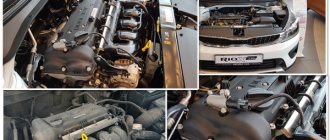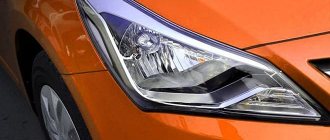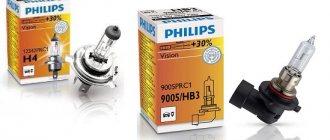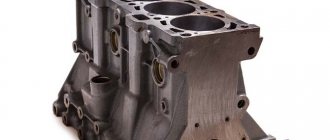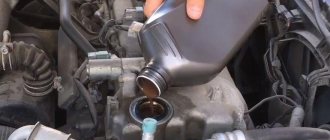Description of G4FA
The G4FA engine has been produced since 2007. The model from the new Gamma family is installed on Korean class B cars, including Solaris and Elantra. The design of the motor includes a lightweight BC with thin cast iron liners.
Engine G4FA
The engine life declared by the manufacturer is 180 thousand km. This is even lower than that of VAZ models. But, of course, with a calm driving style and periodic replacement of worn-out consumables, 250 thousand km is not the limit for this engine. However, a large number of drivers do practically nothing, but only take the car for maintenance according to the schedule. Therefore, after the 100,000th mileage, difficulties begin.
| Type | in-line |
| Number of cylinders | 4 |
| Number of valves | 16 |
| Exact volume | 1396 cm³ |
| Cylinder diameter | 77 mm |
| Piston stroke | 75 mm |
| Supply system | injector |
| Power | 99 - 109 hp |
| Torque | 135 - 137 Nm |
| Compression ratio | 10.5 |
| Fuel type | AI-92 |
| Environmental standards | Euro 4/5 |
| Fuel consumption using the example of a Hyundai Solaris 2011 with a manual transmission, city/highway/mixed, l | 7,6/4,9/5,9 |
| Cylinder block | aluminum |
| cylinder head | aluminum |
| Intake manifold | polymeric |
| Timing drive | chain |
| The presence of a phase regulator on the intake manifold | Yes |
| Availability of hydraulic compensators | No |
| Number of camshafts | 2 |
| Number of valves | 16 |
| What cars was it installed on? | Solaris 1 2011-2017; i30 1 2007-2012; i20 1 2008-2014; i30 2 2012 - 2015; Rio 3 2011 - 2017; Ceed 1 2006 - 2012; 2012 - 2015 |
| Cost, minimum/average/maximum/contract abroad/new, rubles | 35,000/55,000/105,000/1,500 euros/200,000 |
Characteristics
| Production | Beijing Hyundai Motor Co. |
| Engine make | G4FA |
| Years of manufacture | 2006-2018 |
| Cylinder block material | aluminum |
| Supply system | injector |
| Type | in-line |
| Number of cylinders | 4 |
| Valves per cylinder | 4 |
| Piston stroke, mm | 75 |
| Cylinder diameter, mm | 77 |
| Compression ratio | 10.5 |
| Engine capacity, cc | 1396 |
| Engine power, hp/rpm | 100/6000 107/6300 109/6300 |
| Torque, Nm/rpm | 133/4000 135/5000 137/4200 |
| Fuel | 92+ |
| Environmental standards | Euro 4 Euro 5 |
| Engine weight, kg | 99.5 (dry) |
| Fuel consumption, l/100 km (for Kia Rio) - city - highway - mixed. | 7.64.9 5.9 |
| Oil consumption, g/1000 km | up to 600 |
| Engine oil | 0W-30 0W-40 5W-30 5W-40 |
| How much oil is in the engine, l | 3.3 |
| Oil change carried out, km | 15000 (better 7500) |
| Engine operating temperature, degrees. | ~90 |
| Engine life, thousand km - according to the plant - in practice | 180+ 300+ |
| Tuning, hp — potential — without loss of resource | 140 140 |
| The engine was installed | Hyundai i30 Hyundai Solaris KIA Rio KIA Ceed Hyundai i20 Hyundai ix20 KIA Venga |
G4FA Service Regulations
The timing chain works with tensioners, and, as the manufacturer assures, does not require maintenance during its entire operational life. Thermal clearances require manual adjustment, since the G4FA does not have automatic hydraulic compensators. This is done once every 90 thousand km - the valve clearances are adjusted by replacing the pushers. If you ignore this process, it will cause problems.
| Oil service | |
| Replacement frequency | every 15,000 km |
| Needed for replacement | approximately 3 liters |
| Lubricant volume in internal combustion engine | 3.3 liters |
| What kind of oil | 5W-30, 5W-40 |
| Gas distribution mechanism or timing | |
| Timing drive type | chain |
| Claimed resource/in practice | unlimited/150 thousand km |
| Peculiarities | one chain |
| Valve clearances | |
| Adjustment every | 95,000 km |
| Intake clearances | 0.20 mm |
| Release clearances | 0.25 mm |
| Adjustment principle | selection of pushers |
| Replacing consumables | |
| Air filter | 15 thousand km |
| Fuel filter | 60 thousand km |
| Filter in the tank | 60 thousand km |
| Spark plug | 30 thousand km |
| Auxiliary belt | 60,000 km |
| Coolant | 10 years or 210,000 km |
Sores G4FA
Korean engine cylinder head
Let's look at the known problems with the G4FA engine:
- noise, knocking, chattering;
- oil leak;
- floating revolutions;
- vibrations;
- whistling.
Noise in G4FA is caused by two reasons: the timing chain or valve is knocking. In 90 percent of cases, the chain knocks. This usually happens when the engine is cold, then as it warms up, the knocking noise disappears. If a hot engine makes noise, these are valves that require immediate adjustment. As for the chirping sounds and clicks, this is normal, you don’t need to do anything - that’s how the injectors work.
Oil leakage on G4FA is always associated with wear of the cylinder head gasket. You just need to replace it and continue to use the car. But the floating speed is caused by a clogged throttle assembly. You need to clean the damper, and if that doesn’t help, reflash the control unit.
A dirty throttle body can also cause engine vibration at idle. Strong engine jolts also occur from faulty spark plugs or clogged dampers. Replacing the spark-forming elements and cleaning the damper will help solve the problem. Very strong vibrations occur due to the weakened supports of the power plant.
It is noteworthy that the developers themselves warn engine owners that vibrations are possible at medium speeds due to the features of the G4FA model. Due to the universal, characteristic design of the power plant supports, all vibrations are transmitted to the steering wheel and other areas of the car. If at this moment you accelerate or suddenly release the accelerator pedal, the engine will come out of the mesomeric state and the vibrations will disappear.
And finally, a whistle. It comes from a sagging, insufficiently tightened alternator belt. To get rid of the unpleasant noise, you need to change the tensioner pulley.
The G4FA engine is called disposable by repairers. This means that it is difficult to restore; some elements are almost impossible to repair. For example, boring of cylinders to repair size, which is standard for many internal combustion engines, is not provided. We have to change the entire BC. But recently, some Russian craftsmen have learned to line the BC, thereby increasing the service life of the motor.
Engine Kia/Hyundai G4FA
This engine uses a timing chain, which, according to the manufacturer, does not need to be replaced. This motor is installed on Hyundai Solaris and Kia Rio cars. The engine has a system for changing the gas distribution phases of the intake shaft, it does not have hydraulic compensators, and therefore the engine requires valve adjustment and replacement of pushers once every 100 thousand kilometers. This procedure is not cheap, but you shouldn’t neglect it, otherwise vibration, noise and tripping of the engine will appear, and the pistons may burn out.
The G4FA engine is Chinese, but don’t rush to shout “horror”, let’s look at its typical shortcomings, and then we can draw conclusions.
Typical problems and disadvantages of the G4FA internal combustion engine:
1. Knock in the internal combustion engine. If the knocking noise disappears as the engine warms up, then in most cases it is caused by the timing chain, in which case there is no reason to worry. If the engine knocks even after warming up, then most likely it is time to adjust the valves.
2. Noise in the form of clicks, clattering, chirping, etc. There's nothing to worry about either. This is how the injectors of this engine work. There is no treatment.
3. Oil leaks. A rare event. Oil leaks are usually caused by a leaky valve cover gasket. It is treated by replacing it.
4. Floating speed. The problem occurs frequently. It can be treated by cleaning the throttle valve; if this does not help, it is necessary to reflash the engine ECU.
5. Vibration of the internal combustion engine in idle mode. It can be treated by cleaning the throttle or replacing the spark plugs. If the vibration is significant, check the engine mounts.
6. Engine vibration in the rpm range of 2-3 thousand. The cause of this phenomenon has not been identified. “Officials” talk about the features of internal combustion engines. Apply the gas, or vice versa - release the gas pedal, and the vibration will disappear.
7. Whistle from under the hood. A common occurrence is the alternator belt whistling. Moreover, it is not the belt itself that is to blame, but the tensioner, which is time to be replaced - it is not able to properly tension the belt. Treated by replacing the tensioner.
It seems that the listed problems of the specified motor are insignificant and do not require large financial costs. But, it’s worth remembering that all these shortcomings have nothing to do with mileage, and can already arise on a new car. In addition, keep in mind that the G4FA engine is not overhauled; it is impossible to bore its cylinders for repair pistons, because there are no such pistons. In cases where boring is necessary, you can only change the entire block. The service life of this engine is low - 180 thousand km, which is lower than that of VAZ cars.
Yes, with moderate use, timely maintenance, and changing the oil twice as often as recommended by the manufacturer, the engine may last more than 200 thousand km. But this needs to be understood and done exactly this way, but the majority of car owners do not do this, and this must be understood when buying a used car with such an engine. It is highly not recommended to purchase a car with such an internal combustion engine and a mileage of more than 100 thousand km.
In addition to Solaris and Rio, this engine is installed on the second generation Kia Sid and Hyundai i20. Its block serves as the basis for the 1.6-liter G4FC engine. You can find out the engine letters by looking at the cylinder block at the place where the box meets the flywheel.
Tuning options
The easiest and cheapest way to increase the output of this motor is to calibrate it. Special services promise almost 115 horses. Although this is not a big increase. If you want more, change the spider, modify the cylinder head, install larger valves - it’s realistic to remove 125 horsepower from the engine. But this is the limit on the “aspirated” engine; there are no sports shafts for this internal combustion engine.
Installing a turbo kit on a stock CPG is a sure way to significantly hasten the demise of the engine. Before installing the compressor, it is worth installing two gaskets under the head, a forged piston group (although this is very expensive). This will all give approximately 140 hp.
There are also certain options that allow you to increase the power to 180 forces. But such options are comparable in cost to half a car.
Kia/Hyundai G4FA engine characteristics
G4FA modifications
The first modification is the 1.6-liter G4FC. The main differences between them are the volume and the presence of auto valve regulators on the G4FC. In addition, the FA produces 109 hp. s., and FC - 122 l. With. They also have different torque: 135 versus 155, respectively.
Recently, other versions have begun to be produced, already more modified - G4FJ and G4FD. The first unit is with a T-GDI turbine, the second is with a direct injection system. The Gamma family also includes the G4FG.
| G4FC | G4FJ | G4FD | G4FG | |
| Volume | 1.6 liters | 1.6 | 1.6 | 1.6 |
| Exact volume | 1591 cm³ | 1591 cm3 | 1591 cm3 | 1591 cm3 |
| Power | 122 - 128 hp | 177-204 l. With. | 132 - 138 hp | 121 - 132 hp |
| Type | in-line | in-line | in-line | in-line |
| Supply system | injector distributed by MPI | T-GDI direct fuel injection | direct fuel injection type GDI | fuel injection type MPI, that is distributed |
| Number of cylinders | 4 | 4 | 4 | 4 |
| Number of valves | 16 | 16 | 16 | 16 |
| Torque | 154 - 157 Nm | 265 Nm | 161 - 167 Nm | 150 - 163 Nm |
| Compression ratio | 10,5 | 9.5 | 11 | 10,5 |
| Cylinder diameter | 77 mm | 77 mm | 77 mm | 77 mm |
| Piston stroke | 85.4 mm | 85.4 mm | 85.4 mm | 85.4 mm |
| Fuel type | AI-92 | AI-95 | AI-95 | AI-92 |
| Environmental standards | Euro 4/5 | Euro 5-6 | Euro 5/6 | Euro 5 |
| Fuel consumption using the example of a 2009 Kia Ceed with a manual transmission/2012 Hyundai Veloster with a manual transmission/2015 Hyundai i30 with a manual transmission/2021 Hyundai Solaris with a manual transmission, l | 8/5,4/6,4 | 9,3/5,5/6,9 | 6,7/4,4/5,3 | 8/4,8/6 |
| Number of camshafts | 2 | 2 | 2 | 2 |
| Hydraulic compensators | Yes | No | No | No |
Tuning G4FA
Chip training is one of the easy, fast and cheap ways to increase traction. After such tuning, the power will increase to 110-115 hp. With. However, there will be no serious changes unless you install a 4-2-1 spider and increase the diameter of the exhaust pipes. The cylinder head will also need to be modified - the valves will need to be enlarged - and re-flashing. In this case, you can achieve an increase in power up to 125 hp. With. And if you add all this with sports camshafts, the engine will become even stronger.
What can chipping an internal combustion engine give?
Installing a compressor is the second tuning option. This is an extreme modernization measure, since the engine life in this case is noticeably reduced.
- It is possible to prepare a new lightweight PN group for the ratio of the above-piston space to the combustion chamber volume of 8.5. Such a piston can easily withstand a pressure of 0.7 bar (not a very productive turbine).
- For some strengthening of the cylinder head, it is recommended to install 2 gaskets instead of one. This is much cheaper, but this option will only withstand a boost of 0.5 bar.
In addition to the compressor itself, a new exhaust with a pipe diameter of 51 mm is installed. Engine power will increase to 140 hp. With. If you additionally machine the intake/exhaust channels, the engine will increase to 160 hp. With.
Installing a turbine is the third option for modifying the G4FA engine. However, in this case a more professional approach is needed. First of all, we need to weld a new reinforced manifold for the Garrett 15 or 17 turbine. Then organize an oil supply to the turbine, install an intercooler, 440 cc injectors and build a 63 mm exhaust. It cannot do without shafts, which should be made with a phase of approximately 270 and good lift. A properly tuned turbine will increase power up to 180 hp. With. The method is expensive - it costs almost half the price of the car.
The video shows the process of lining a 1.4L petrol G4FA engine block from Hyundai Solaris, Kia Rio and Kia Ceed (Hyundai Solaris, Kia Rio, Kia Ceed, etc.) with cast iron liners.
The cylinder block liner of the Hyundai Solaris 1.4 petrol engine with the marking: G4FA is part of the engine overhaul.
Lining G4FA is a rather technically complex process, so you won’t be able to do it yourself in your garage. The Kia Rio 1.4 block liner is used in cases where the cylinders have already exhausted their repair life, and boring will be ineffective or completely useless. There are also engines that do not require boring the block for a repair piston group at all. In addition, if the block has already been previously bored to the maximum repair size, there is no other option other than its sleeve. In all of the above cases, liners are used, which serve as new cylinder walls.
We perform the following repair operations on the Kia 1.4 G4FA unit:
- Boring for repair pistons
- Repair of crankshaft and camshaft bed
- Grinding the crankshaft
- Replacing the valve seat and guide
- Cylinder head milling
- Crimping
- Technical Washing
- Adjusting valve clearances
- Camshaft repair
- Welding cracks
After a special initial diagnosis, which is carried out using a bore gauge, one of the following decisions is made:
- Installing new liners in the engine block for a standard piston size
- Boring the cylinder block to fit the repair piston size
Many factors influence the deterioration of the cylinder walls. These include not only the natural wear and tear of the engine and cylinder block in particular, but also the ingress of foreign objects, the use of low quality oil and fuel (or driving with a low oil level), and engine overheating (violation of the temperature regime in general). When any problems arise with the Hyundai Solaris 1.4 engine, it is better to immediately contact specialists. So, you will not only save your time, but also prevent the situation from getting worse. Moreover, when the first signs of deterioration in engine performance appear, you can avoid replacing it and buying a new one by repairing individual parts, in particular the cylinder block liner.
- is a fairly popular request. And not without reason, because this is a very good service that can restore and improve the condition of the engine. In addition, after diagnostics and troubleshooting, we will be able to tell you the final repair price and if it is high, then we can replace your engine with a contract one.
Residents of Moscow and Moscow Region can come to our repair shop to line their engine any day of the week from 9:00 to 19:00. If there is no time or opportunity to come to you, we can send a courier, he will pick up your engine and bring the already lined motor back the next day. Residents of remote regions can use the services of any transport company.
If you notice any problems with the engine, don’t hesitate and call right away, we’ll help you fix any of your problems!
